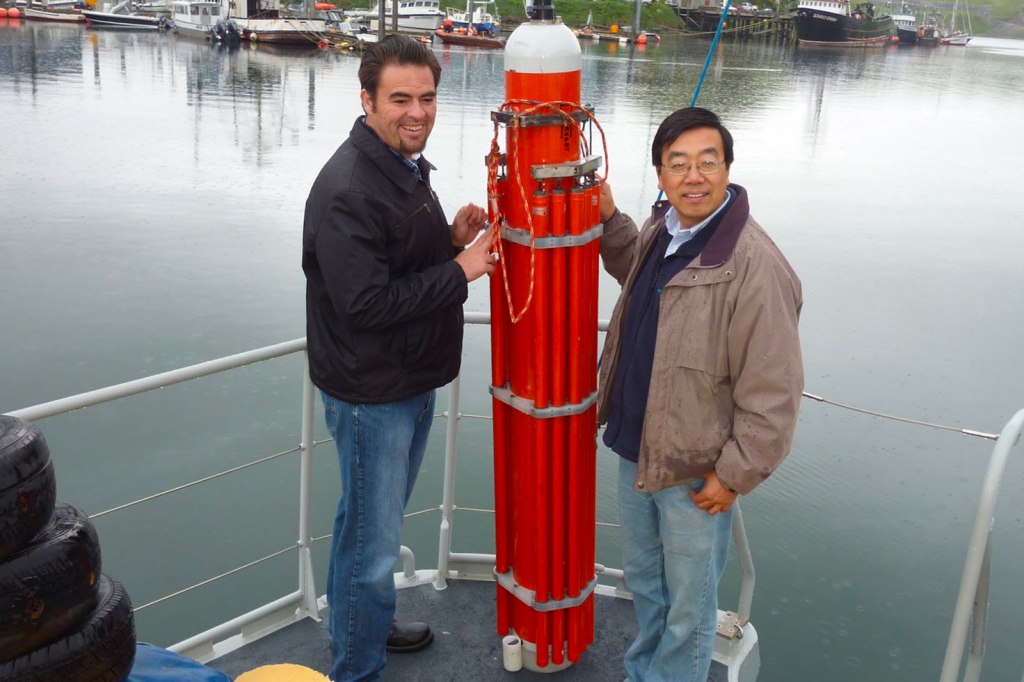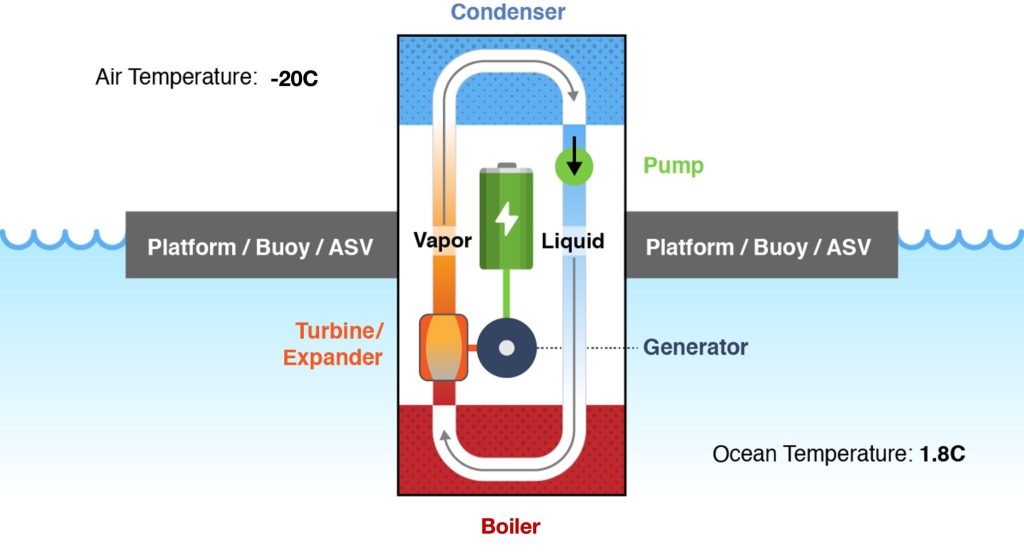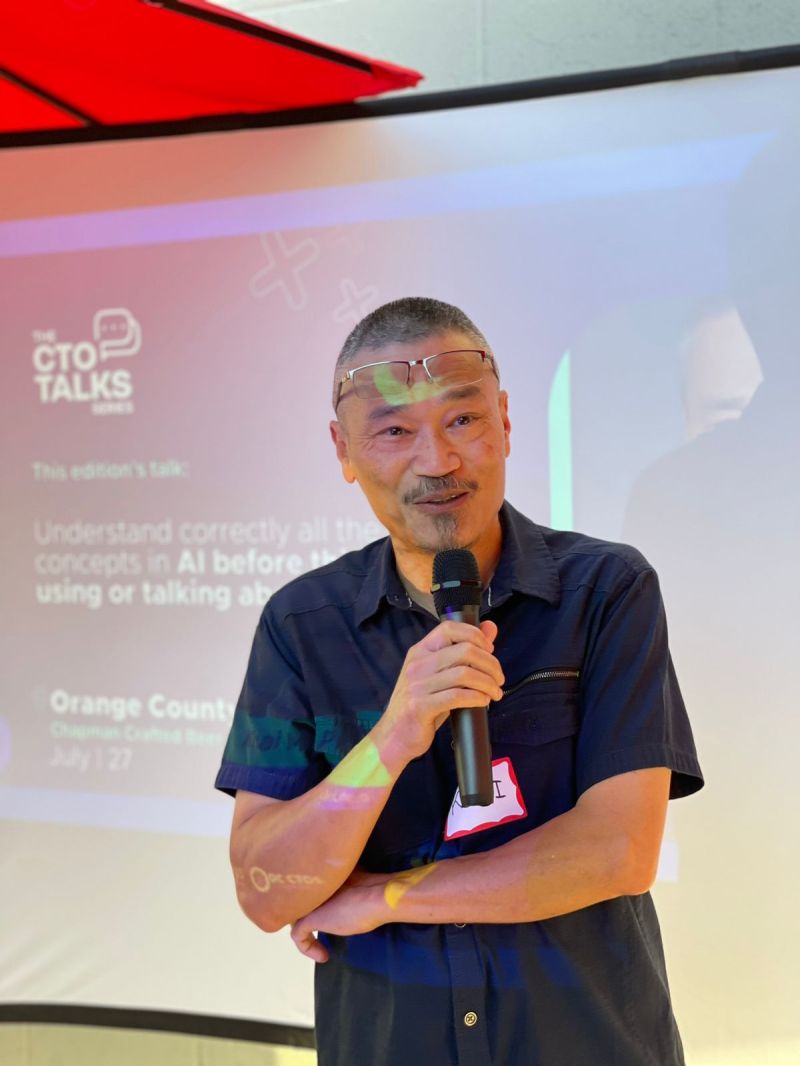I was delighted to have the opportunity to speak with Dr. Yi Chao, Founder and CEO of Seatrec, a startup that designs and manufactures products that generate electricity from the temperature fluctuations in the ocean.
When I first heard about this technology, it almost sounded like magic! A way to generate energy just from the naturally occurring ocean changing temperature? Wow!
It turns out that it’s actually not that new of an idea – the research has been around since the 1970s, but generating enough energy from these fluctuations to, say, power the energy grid, is remarkably expensive.
This is where Seatrec is different. They’ve scaled this technology down to essentially provide infinite, sustainable energy to power research instruments, like undersea robots. Currently, these robots have to completely rely on the dwindling charges of battery packs, brought to them by researchers on ships – making research costly, difficult, and primarily close to shore. Thanks to Seatrec’s technology, researchers are no longer beholden to voyaging out on ships, and can gather more data from autonomous robots that can endure missions for much longer in harsher conditions – sparking the next generation of ocean data insights.
You’ll learn about how Seatrec uses this technology to power ocean research all around the globe, how Yi’s science background made him more resilient for the business world, and some of the major research successes that this technology has enabled.
It was a great interview with a company on the cutting edge of energy and ocean research. If you’d like to learn more, you can explore Seatrec’s website!

I’m chiefly interested in the concept of resilience – personal, communal, and societal. What does the concept of resilience mean to you and Seatrec?
For us at Seatrec, we’re primarily concerned with societal resilience, since we deal with the planet’s resources. We’re totally ocean focused. There’s only so much land on earth, but over 70% of the planet is covered by the ocean. So it makes sense to turn to the ocean to find solutions to problems that we can’t solve by land!
Everyone knows about traditional ocean industries like shipping, but there are a lot of interesting things being done with resource exploration in the ocean – whether it’s oil and gas, offshore energy, offshore wind farming, or even growing our own protein instead of fishing. The ocean is becoming more and more important – and as it becomes more important, it’s also in more danger.
Seatrec was formed so we can understand the ocean in a deeper way, manage our resources, and protect our ocean. We’re bringing new and innovative technology to study the ocean and collect data.
Really, when it comes down to it, our mission is to digitize the ocean and capture the ocean’s data, so we can better understand and predict the ocean – all so we can better protect this vital resource.
I feel when people think about the ocean and generating energy, most people think about waves. However, you generate energy from the ocean’s temperature fluctuations. Can you talk about how you’re solving that problem, and the approach you’re taking?
Sure! So the concept of OTEC (or, ocean thermal energy conversion) is actually not that new.
The first wave of dealing with renewable ocean energy, including OTEC, was back in the 1970s. A lot of research was done back then that pioneered the whole field – studies were done with ocean thermal energy, ocean waves, ocean wind, everything. A number of different governments spent a lot of money on renewable energy to support the innovation, but when the oil crisis ended, everyone just went back to gasoline like nothing had happened. A lot of the research only started to come back in the recent decades.
The technology for ocean thermal energy conversion is relatively mature, but it’s very costly. You have limited geographic distribution since you have to work in the tropics where the water is warm. You then have to pump cold water up from the deep ocean. Converting that small difference into energy is rather costly, and is just unrealistic to use that energy to supply the power grid.
This is actually why you’ll hear a lot more about offshore wind when it comes to the ocean. Ocean waves are still in the early stages of commercialization as well.
Where we come in is, we decided to utilize ocean thermal energy to power sensors and underwater robotics, not the power grid. We want to focus on ocean sensing, to provide ocean intelligence, and this can support other forms of energy – like providing data for the offshore wind energy market, and to help those companies optimize the planning, the sights, quantify impact, monitor their operations. And that’s a unique angle.
So, would it be fair to say that your technology is like a recharging battery pack that could go on measurement instruments, allowing those instruments to stay out longer and be more self-contained?
Yes, that’s correct!
Essentially, we deliver the first self-charging underwater subsea robot. There are a lot of robots on the surface. They can be powered by solar, wind, and waves. But ours is the first that can power itself underneath the water. We can go as deep as 1000 meters today, and, if we want to, even as deep as 2000 meters in the near future! Today’s subsea robots are powered by batteries with limited lifetime and capabilities. When the battery runs out, we need to send ships to replace those dead batteries or the robots fall to the bottom of the ocean. If you want to collect data far offshore, you need to use a bigger ship. This causes a huge carbon footprint, there need to be lots of people onboard, and it’s just extremely costly. Ship time starts to cost tens of thousands of dollars a day!
Our robot can recharge its batteries without the need of ships, and therefore be scaled up. Today, there are thousands of subsea robots in the ocean. In the next decade, this number will go up tenfold or even hundredfold.
When I was researching this company, I see that you’re the rare oceanographer who stays far away from the ocean due to seasickness! I’m glad to see that didn’t stop you.
I was trained as an ocean scientist, and I have a Ph.D. in oceanography from Princeton University. I then worked at NASA’s Jet Propulsion Lab in Pasadena for many years. And even though my work was related to the ocean, I tried to stay away from the ocean as long as I could! For example, I developed a satellite to measure salinity on the surface of the ocean, from hundreds of miles away, using remote sensing technology – so I studied the ocean from space!
Through my work, I continued developing computer models of the ocean and studying it that way. And eventually I thought, if I can develop robots that go to sea, I don’t have to physically go on ships! As long as I can measure the water, I think I’ll be happy.

Startups are notoriously prone to risk. What are some ways you’ve worked to build resilience within your company?
The biggest risk for any startup is cash flow. How do you stay alive? How do you find just enough capital to help you grow? You don’t want to grow too fast, because you may not have the right product that fits the market. And then, of course, you always have to make payroll at the end of every pay period. Cash flow is the challenge we are constantly struggling with.
The ocean market is very fragmented. It’s not as well-defined as other areas like consumer products, or startup categories like fintech or agtech. The market is emerging. It’s still new. My goal, the biggest challenge, is finding the product that fits the market, so we can raise the capital and grow. How do you get your product to take off?
That’s my job, mainly. Opening up new markets, coordinating different sectors of the market, defining the market, and product market fit. Then, finding the right time to scale. Raising money from investors and then growing and scaling our technology in the marketplace!
You have a significant background in engineering and oceanography. Has there been any surprising crossover from the science world to the business world? Anything that’s been a particularly good fit?
I think as a scientist, you automatically build resilience. I do experiments, and they often fail. But then, eventually, you pick a new way, and make it right the next time! And you keep trying and trying to get it right. That’s my mentality, and I think that will carry through my entrepreneurial career.
Being a first-time entrepreneur, I’ve read lots of books, talked to lots of mentors and different people who have experience to grow from 0 to 1 and implement deep tech successfully in the commercial market. That’s helped guide me day to day, and helped me keep looking forward and following my vision into the future, but at the same time staying focused on the present enough to continue making payroll and scaling the company.
San Diego’s biotech scene is well-regarded. And Seatrec seems to be especially relevant to the San Diego area, poised to take advantage of engineering and oceanography pipelines from universities like UCSD and Scripps. How would you describe the San Diego business scene? Are there any pros and cons that you see about being in San Diego?
We actually moved to San Diego for precisely that reason! Los Angeles is great for certain areas of tech, like consumer tech and aerospace. But I think that San Diego is one of the few ideal locations in the country to grow a blue tech company!
As you mentioned, we have the Scripps Institution of Oceanography, all the engineering out of UCSD, a big naval presence, and access to supply chains. You have the port, coast guards. Even the border. I see all of these not just as adding to our intellectual capacity, but as an opportunity with many stakeholders and potential customers – not just from the research side, but from the defense and military side.
We also have a great investor ecosystem – there are lots of investors in San Diego that support our industry. Really, San Diego is the perfect place to grow into our next chapter.

Have there been any major successes that Seatrec has celebrated?
Yes! Recently, one of the biggest successes we’ve seen is opening up a new market and making the customer very happy. We were able to enable the customer to do something that they were not able to do in the past.
For the first time, we were able to add an acoustic hydrophone, an underwater listening device, to our robots. This was impossible before due to power limitations. We deployed our robots in the ocean out in Monterey and we heard whales singing! It’s tough to see what’s happening under the water, but sound provides a way to discover what’s going on. In fact, when it comes to the ocean, it’s all about sound.
This hydrophone was really cool. It provides almost like a natural fingerprint of all the activity of the ocean, from the natural sounds of the wind and waves, to the manmade sound of the ships and other vessels, then the marine mammals and the rest of the ecosystem. We can learn how all of these groups interact together.
It was very interesting – traditionally, those hydrophones have to be powered by ships, and the surface is extremely noisy, so you couldn’t hear very well. Our robot, on the other hand, can dive much deeper where it’s much quieter. You can hear for miles and miles. It’s a lot like how if you were building a telescope, you’d want to build it on the top of a mountain. That’s the same principle with this ocean robot!
So that’s really our major milestone – our customers can now do something that’s never been done before. We get to enable other technologies too. We can build our business model around these early customers and early technology adopters. And this makes us very excited to grow and make our investors happy about the total available market.
Looking ahead, what do you see as the future for Seatrec? Are there any opportunities or risks you are working to navigate?
In the near term, well, we launched our product early this year. We’ve been going to a few trade shows, getting customer feedback. We’ve been very encouraged about the traction so far, and there is product market fit. Ocean tech is hard – it’s taken years of engineering and commercialization efforts, but we have a strong differentiator to sell! We have some significant sales so far, and we interest for increased sales targets for next year.
We hope to break even on our current operation next year, that’s our main milestone. And then, further out, we want to take the opportunity to scale. We’re planning to fundraise our Series A next year to put some more fuel in the fire. We want to take Seatrec to the next level.
Then, in addition, we also have a really interesting project called Project FIND. This project is really about providing this cutting edge technology, and our robots, to researchers and customers who traditionally can’t afford them or don’t have the opportunity.
We launched this project two years ago, hoping to provide cutting edge technology, like the same type of technology a researcher at Scripps would have, to countries and researchers who normally can’t access it. The ocean is global, it affects everybody. So everybody should be able to study and protect it. And we hope that, if people are interested, they can reach out to us, be a part of it, and can help out.
So through Project FIND, you provide your technology to different countries to help foster more scientific exploration?
Yes!
Our end-to-end product with the platform and sensors sells for between $50,000 -$75,000. That’s what we sell to universities, researchers, nonprofits, and the government. But we’ve been able to provide one to Mexico already, as well as Brazil and South Africa. We’re working on two more for Sri Lanka and Ghana. They’re very interested in the hydrophone I mentioned earlier. A lot of researchers in Sri Lanka, for example, monitor whales. They have conservation programs, they understand the ocean. But they have to use binoculars to identify whales! If we can provide a hydrophone robot to them that lets them hear for miles, they can expand their search area and better understand whale behavior protect their part of the ocean.
What are the best ways for people to learn about, or get involved with, Seatrec?
You can certainly check out our website, or follow us on LinkedIn or Twitter. We have some interesting projects coming up!
Want to go more in depth? Learn more here:



Leave a comment